Recently updated on June 3, 2025
Various approaches to blockchain software development and the utilization of distributed ledger systems have resulted in different types of blockchain.
Whether it’s a fully open network accessible to anyone or a restricted system for select participants, understanding the different blockchain types is essential for grasping their potential applications.
This article explores the main blockchain categories, their unique features, and how they cater to various industries.
Why Different Blockchain Types?
Different blockchain types exist because no single approach fits every use case. Some businesses need complete openness and public participation, while others prioritize privacy and restricted access.
Additionally, factors like transaction speed, scalability, and governance structures play a crucial role in shaping blockchain design.
So, how many different blockchains are there? Primarily, there are four main types:
Additionally, blockchains can also be classified based on access control as:
Each type serves distinct purposes and comes with its own set of merits and demerits. The importance of having different types of blockchains lies in the following:
- Different security and privacy needs. Some industries require restricted access to sensitive data, while others rely on openness.
- Scalability matters. Some blockchains prioritize speed and high transaction volumes, while others focus on security and decentralization.
- Decentralization levels. Not every organization needs complete decentralization—some prefer a controlled environment.
- Regulatory compliance. Some blockchains are specifically built to help businesses comply with legal and data governance requirements.
4 Different Types of Blockchain
Let’s examine the 4 types of blockchain networks, including their characteristics, benefits, drawbacks, and examples.

Public Blockchain
A public blockchain is an open and decentralized network where anyone can participate, read, and validate transactions.
Characteristics:
- Fully decentralized and open to all participants
- Operates on a consensus mechanism like Proof of Work (PoW) or Proof of Stake (PoS)
- High transparency and security
Pros:
- No central authority
- High security due to network size and cryptographic mechanisms
- Transparent and immutable transactions
Cons:
- Slower transaction speed and scalability issues (e.g., Bitcoin network congestion)
- Higher energy consumption in PoW-based networks
Examples: Bitcoin, Ethereum, Solana.
Private Blockchain
A private blockchain is a permissioned network controlled by a single organization or entity.
Characteristics:
- Limited access, requiring permission to join
- Faster transaction speeds due to fewer nodes
- More centralized governance
Pros:
- Higher efficiency and scalability
- Greater privacy and security for sensitive data
- Regulatory compliance is easier to maintain
Cons:
- Less transparency and decentralization
- Higher risk of manipulation by the central authority
Examples: Hyperledger Fabric, Ripple, Quorum.
Consortium Blockchain (Federated Blockchain)
A consortium blockchain is a semi-decentralized network where multiple organizations share control over the blockchain.
Characteristics:
- Partially decentralized with a select group of entities maintaining the network
- Better efficiency than public blockchains
- More secure than fully centralized systems
Pros:
- Faster transaction processing compared to public blockchains
- Shared control prevents a single point of failure
- Suitable for industry-wide applications
Cons:
- Less transparent than public blockchains
- Complex governance structures
Examples: IBM Food Trust, Energy Web Foundation, Corda.
Hybrid Blockchain
A hybrid blockchain combines features of both public and private blockchains. This allows organizations to control access while keeping some aspects of the network public.
Characteristics:
- Controlled permissions with selective transparency
- Flexibility to switch between public and private settings
- Enhanced security and efficiency
Pros:
- Offers the best of both worlds: security, transparency, and efficiency
- Highly customizable for different use cases
- Greater scalability than purely public blockchains
Cons:
- Implementation complexity
- Governance issues between public and private elements
Examples: Dragonchain, XDC Network, Komodo.
Permissionless vs. Permissioned Blockchain
Beyond the four main types of blockchain technology, blockchain networks can also be categorized based on access control:

Permissionless Blockchain
A permissionless blockchain allows anyone to participate in the network without requiring approval. These blockchains operate on decentralized principles.
Some features of permissionless blockchains are:
- No restrictions on who can join, read, or write data to the blockchain.
- All transactions are publicly recorded, ensuring transparency and accountability.
- No central authority controls the network, reducing the risk of censorship and single points of failure.
- Used in decentralized finance (DeFi), NFTs, and global peer-to-peer transactions.
While permissionless blockchains provide greater inclusivity and security through decentralization, they also face scalability issues, higher energy consumption (in PoW networks), and potential regulatory concerns.
Permissioned Blockchain
A permissioned blockchain is a private or consortium-based network whose access is restricted to authorized participants. It requires identity verification and approvals from a central authority or governing body.
Key features of permissioned blockchains include:
- Only approved users can access and contribute to the network.
- Transactions and data remain confidential within the network.
- Since fewer nodes participate in validation, transactions are faster and require less computational power.
- Commonly adopted by businesses, banks, and government institutions for secure record-keeping, supply chain management, and financial services.
Well-known examples of permissioned blockchains include Hyperledger Fabric, Corda, and Quorum.
Key Differences Between Blockchain Types
While all types of blockchains share the core principles of security and transparency, they differ in certain characteristics:
| Feature | Public Blockchain | Private Blockchain | Consortium Blockchain | Hybrid Blockchain |
| Access & Permissions | Open to anyone | Restricted to a single entity | Restricted to a group of entities | Mix of public and private access |
| Decentralization | Fully decentralized | Centralized | Partially decentralized | Combination of centralized and decentralized elements |
| Security | Highly secure due to decentralization | Secure but depends on internal governance | Secure with shared control | Strong security with flexible settings |
| Scalability | Low (slow transaction speed) | High | Moderate | High |
| Use Cases | Cryptocurrencies, DeFi, smart contracts | Enterprise applications, supply chains | Banking, healthcare, supply chain consortium | Enterprise solutions with some transparency |
Conclusion
As explained in the sections above, multiple network types are each suited for different needs. These include the openness of public blockchains, the controlled access of private ones, and the balance found in consortium and hybrid models.
Understanding these types of blockchains can help businesses and developers build secure and efficient systems. The choice ultimately depends on the level of security, transparency, and scalability required.
Regardless of the approach, blockchain continues to decentralize industries, transforming how we handle data, transactions, and trust in the digital world.
If you are looking for an experienced partner providing expert crypto development services, consider Kindgeek. From ideation to deployment and beyond, our team guides you through the entire process of developing innovative cryptocurrency and blockchain-powered fintech products, with a focus on transparency, user experience, and bulletproof security.




